Home >Web Front-end >JS Tutorial >How to write vue plug-in examples to share
How to write vue plug-in examples to share
- 小云云Original
- 2018-01-05 13:20:512364browse
Before learning, ask yourself why you want to write a vue plug-in. This article uses a simple example to teach you how to write a vue plug-in and what needs to be paid attention to. Readers who need it can follow along and learn.
In a project, especially a large project, there are many parts that need to be reused, such as loading animations and pop-up boxes. It is a little troublesome to reference one by one, and if there are too many components referenced in a vue file, the code will appear bloated, so there is a need to encapsulate the vue plug-in.
After talking about the requirements, let’s take a look at the specific implementation. At present, I have tried two different plug-in writing methods, and I will introduce them one by one.
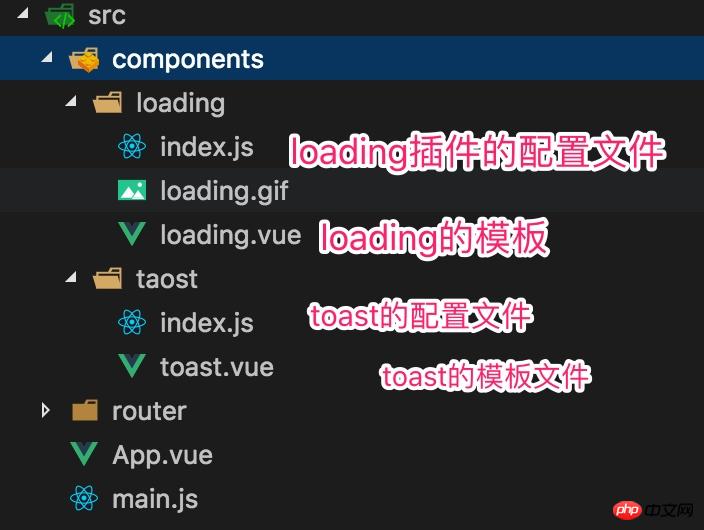
This is my project directory. The general structure is explained like this, as simple as possible and easy to understand.
One is the loading plug-in and the other is the toast plug-in. The difference is that the loading plug-in is introduced as a component, while the toast plug-in is directly added to the mount point and called by changing the status of the method.
Currently used is Jiangzi:

toast plug-in
There are two files under the toast file, the file with the suffix vue is The skeleton of this plug-in, the first js file is to put this skeleton into the Vue global and write the operation logic.
You can take a look at the content of toast.vue:
<template>
<transition name="fade">
<p v-show="show">
{{message}}
</p>
</transition>
</template>
<script>
export default {
data() {
return {
show: false,
message: ""
};
}
};
</script>
<style lang="scss" scoped>
.toast {
position: fixed;
top: 40%;
left: 50%;
margin-left: -15vw;
padding: 2vw;
width: 30vw;
font-size: 4vw;
color: #fff;
text-align: center;
background-color: rgba(0, 0, 0, 0.8);
border-radius: 5vw;
z-index: 999;
}
.fade-enter-active,
.fade-leave-active {
transition: 0.3s ease-out;
}
.fade-enter {
opacity: 0;
transform: scale(1.2);
}
.fade-leave-to {
opacity: 0;
transform: scale(0.8);
}
</style>
There are only two main contents here, which determine whether to display them or not. show and message of what content is displayed.
After a quick look here, do you find any problems?
There is no props attribute in this file, that is, whether it is show or message, there is no way to modify it through parent-child component communication. So how do they handle it correctly? Of. Don't worry, let's take a look at his configuration file.
index.js:
import ToastComponent from './toast.vue'
const Toast = {};
// 注册Toast
Toast.install = function (Vue) {
// 生成一个Vue的子类
// 同时这个子类也就是组件
const ToastConstructor = Vue.extend(ToastComponent)
// 生成一个该子类的实例
const instance = new ToastConstructor();
// 将这个实例挂载在我创建的p上
// 并将此p加入全局挂载点内部
instance.$mount(document.createElement('p'))
document.body.appendChild(instance.$el)
// 通过Vue的原型注册一个方法
// 让所有实例共享这个方法
Vue.prototype.$toast = (msg, duration = 2000) => {
instance.message = msg;
instance.show = true;
setTimeout(() => {
instance.show = false;
}, duration);
}
}
export default Toast
The logic here can be roughly divided into the following steps:
Create a An empty object. This object is the name of the plug-in that will be used in the future. In addition, there must be an install function in this object. Use vue's extend method to create a plug-in constructor (which can be seen as creating a subclass of vue), instantiate the subclass, and all subsequent operations can be completed through this subclass. Then add a shared method to the Vue prototype.
What needs to be mentioned here is Vue.extend(). For example, our daily use of vue to write components looks like this:
Vue.component('MyComponent',{
template:'<p>这是组件</p>'
})
This is the registration method of the global component, but in fact it is a Syntactic sugar, the real running process is like this:
let component = Vue.extend({
template:'<p>这是组件</p>'
})
Vue.component('MyComponent',component)
Vue.extend will return an object, as mentioned in most information, It can also be said that it returns a subclass of Vue. Since it is a subclass, there is no way to directly use the methods on the Vue prototype through it, so a new instance is needed to use it.
In the code console.log(instance)
the result is this:
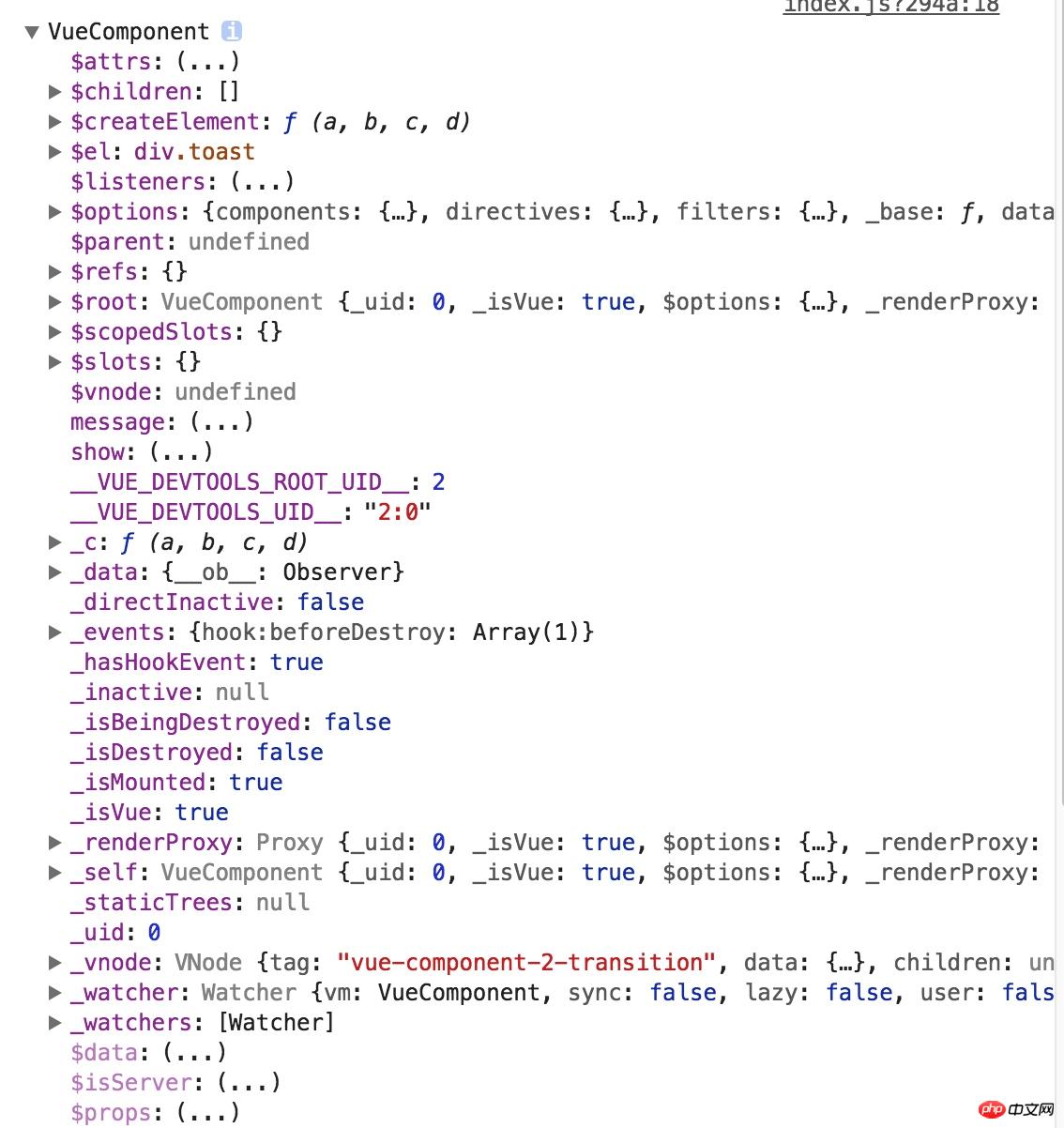
You can see $el:p.toast
is the root node of the toast component template.
What’s confusing is that I don’t know why I need to create an empty p node and mount this instance on it. I tried commenting this code, but when I run it I get an error.
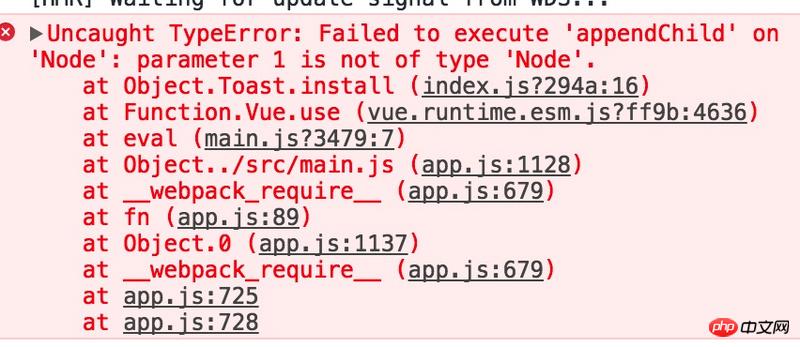
Looking for the cause of this error, it seems to be because of
document.body.appendChild(instance.$el)
# inside ##instance.$el question, okay, let’s check this in the console. WTF! ! ! ! The result turned out to be undefined.
console.log(instance)
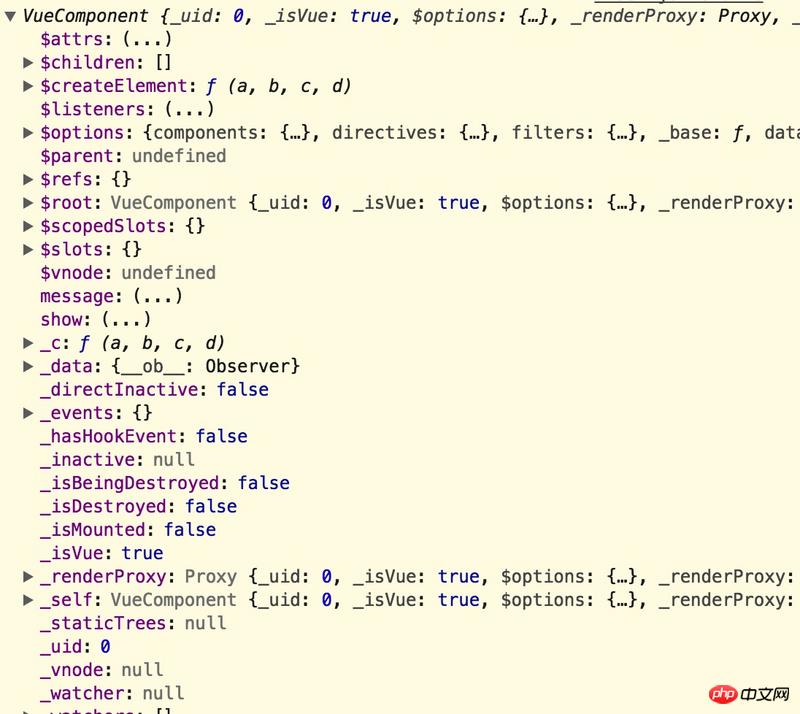
instance.$mount(document.createElement('p')), the mount point no longer existed. Then I tried to change this sentence:
instance.$mount(instance.$el)$el magically came back again………………No problems have been found with this change for the time being. It can be run as above. But in any case, this means that the instance must be mounted on a node for subsequent operations. The code after is simple. It is nothing more than adding a method to change the plug-in state on the Vue prototype. Then export this object. The next step is how to use it. Let’s take a look at how main.js is written:
import Vue from 'vue'
import App from './App'
// import router from './router'
import Toast from './components/taost'
Vue.use(Toast)
Vue.config.productionTip = false
/* eslint-disable no-new */
new Vue({
// router,
render: h => h(App)
}).$mount('#app') This way you can use it directly in other vue files, like this:
// app.vue
<template>
<p id="app">
<loading duration='2s' :isshow='show'></loading>
<!-- <button @click="show = !show">显示/隐藏loading</button> -->
<button @click="toast">显示taost弹出框</button>
</p>
</template>
<script>
export default {
name: "app",
data() {
return {
show: false
};
},
methods: {
toast() {
this.$toast("你好");
}
}
};
</script>
<style>
#app {
font-family: "Avenir", Helvetica, Arial, sans-serif;
-webkit-font-smoothing: antialiased;
-moz-osx-font-smoothing: grayscale;
text-align: center;
color: #2c3e50;
margin-top: 60px;
}
</style> Control the $toast written on the Vue prototype to operate the toast component by adding a method in methods.
这样toast组件的编写过程就结束了,可以看到一开始gif图里的效果。
loading插件
经过上一个插件的讲解,这一部分就不会那么细致了,毕竟大多数都没有什么不同,我只指出不一样的地方。
<template>
<p class='wrapper' v-if="isshow">
<p class='loading'>
<img src="./loading.gif">
</p>
</p>
</template>
<script>
export default {
props: {
duration: {
type: String,
default: "1s" //默认1s
},
isshow: {
type: Boolean,
default: false
}
},
data: function() {
return {};
}
};
</script>
<style lang="scss" scoped>
</style>这个就只是一个模板,传入两个父组件的数据控制显示效果。
那再来看一下该插件的配置文件:
import LoadingComponent from './loading.vue'
let Loading = {};
Loading.install = (Vue) => {
Vue.component('loading', LoadingComponent)
}
export default Loading;这个和taoat的插件相比,简单了很多,依然是一个空对象,里面有一个install方法,然后在全局注册了一个组件。
比较
那介绍了这两种不同的插件编写方法,貌似没有什么不一样啊,真的是这样么?
来看一下完整的main.js和app.vue这两个文件:
// main.js
import Vue from 'vue'
import App from './App'
// import router from './router'
import Toast from './components/taost'
import Loading from './components/loading'
Vue.use(Toast)
Vue.use(Loading)
Vue.config.productionTip = false
/* eslint-disable no-new */
new Vue({
// router,
render: h => h(App)
}).$mount('#app')
// app.vue
<template>
<p id="app">
<loading duration='2s' :isshow='show'></loading>
<!-- <button @click="show = !show">显示/隐藏loading</button> -->
<button @click="toast">显示taost弹出框</button>
</p>
</template>
<script>
export default {
name: "app",
data() {
return {
show: false
};
},
methods: {
toast() {
this.$toast("你好");
}
}
};
</script>
<style>
#app {
font-family: "Avenir", Helvetica, Arial, sans-serif;
-webkit-font-smoothing: antialiased;
-moz-osx-font-smoothing: grayscale;
text-align: center;
color: #2c3e50;
margin-top: 60px;
}
</style>可以看出来,loading是显示的写在app.vue模板里的,而toast并没有作为一个组件写入,仅仅是通过一个方法控制显示。
来看一下html结构和vue工具给出的结构:
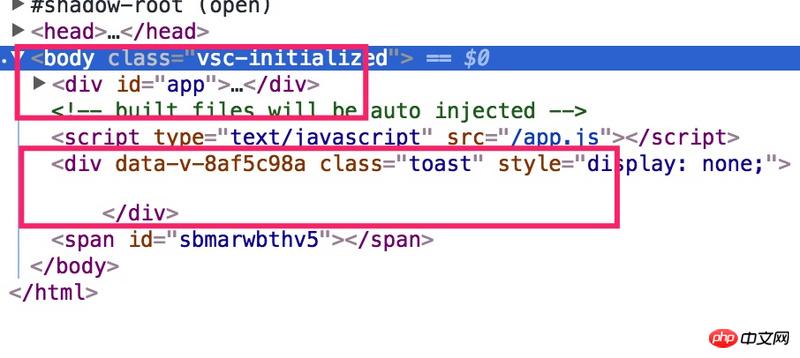
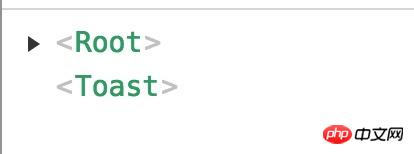
看出来了么,toast插件没有在挂载点里面,而是独立存在的,也就是说当执行
vue.use(toast)
之后,该插件就是生成好的了,之后的所有操作无非就是显示或者隐藏的问题了。
相关推荐:
The above is the detailed content of How to write vue plug-in examples to share. For more information, please follow other related articles on the PHP Chinese website!
Related articles
See more- An in-depth analysis of the Bootstrap list group component
- Detailed explanation of JavaScript function currying
- Complete example of JS password generation and strength detection (with demo source code download)
- Angularjs integrates WeChat UI (weui)
- How to quickly switch between Traditional Chinese and Simplified Chinese with JavaScript and the trick for websites to support switching between Simplified and Traditional Chinese_javascript skills

